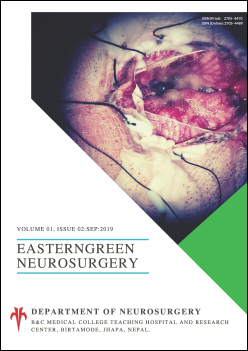Usefulness of Neuronavigation During Cranial Surgery
DOI:
https://doi.org/10.3126/egn.v1i2.25729Keywords:
Neuronavigation, Frameless sterotactic, Image guided surgery, Meningioma Steriotatic biopsyAbstract
Background: Neuronavigation helps neurosurgeons by providing intraoperative three dimensional (3D) view of CT/MRI of the patients thus helping the surgeon in different steps of surgery. With the objective to evaluate the usefulness of neuronavigation in early years after installment, this study was conducted at a tertiary care center in Nepal.
Methodology: This is a prospective analytical study, where all the consecutive cases of the neurosurgical cranial cases using frameless stereotactic (Medtronics stealth station 7), were considered during May 2014 to March 2017. All the lesions were categorized according to the location and were evaluated using the Image guided surgery (IGS) score. Analysis was done using stratification and percentage system.
Result: There were total 122 cases operated using neuronavigation during the study period, with ages ranged between 5 to 83 years with mean age 38.32(SD16.09) years. 57.4% were male and 42.6% were female. Overall IGS scoring of the neuronavigation in the different location showed irreplaceability in 100% cases of convexity, ganglionic/ deep seated/ ventricle and brain stem lesion; however, it was more useful than conventional methods in 70.37% of lobar cases. Similarly, overall IGS scoring of neuronavigation in the different type of lesions showed irreplaceable in 80% of meningiomas, and 41.17% of gliomas; however, was more useful than conventional methods in 56.86% of gliomas
Conclusion:Use of neuronavigation seems to be irreplaceable for planning and raising flaps, in cases of convexity lesions and most of the cases of lobar and ganglionic/ deep seated leasions.




